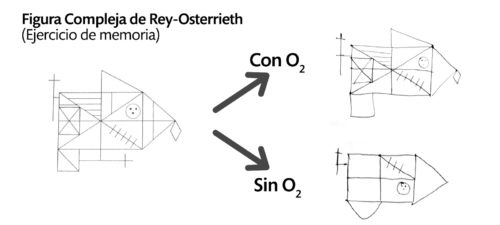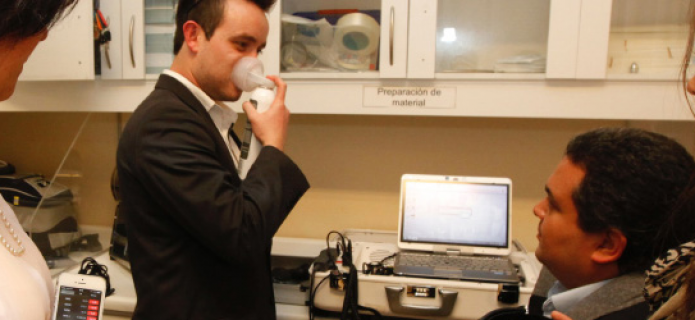ALMA, a natural laboratory for high-altitude medicine
Health experts took part in an important multidisciplinary meeting at the ALMA Observatory facilities, where they shared experiences and research on medicine at high geographic altitude, with a particular focus on a condition known as intermittent hypoxia –lack of oxygen– which has only been studied among mountain climbers.
About 50 people participated in the seminar, which was held on September 23-25 at the Operation Support Facility (OSF, at 2,900 meters altitude). Those attending included the Latin America Health Manager for Barrick Gold Corporation; the Health Superintendent at Toromocho mine in Peru; representatives of Carabineros de Chile (the uniformed police); the Chilean Safety Association; the APEX Observatory; executives from Indura, Correa Ingeniería, ESACHS and Medicina de Altura; and medical specialists from the University of Calgary in Canada, Universidad Católica del Norte, Universidad de Chile and Tocopilla Hospital.

Fig. 1: Medical team observing eye fundus and monitoring heart with a telemedicine machine that can be controlled from all over the world through an internet connection. Credit: ALMA(ESO/NAOJ/NRAO), Carlos Padilla
"ALMA offers a unique opportunity to study physiological adaptation and human action at high geographic altitude," said Marc Poulin, a doctor from the University of Calgary. "In addition to its location at high altitude, people from all over the world work at ALMA. Therefore, it's an interdisciplinary and multicultural environment where specialists like us hope to advance the knowledge frontier in terms of what the human body can do."
Members of communities that have historically lived at high geographic altitude have succeeded in adapting to lower oxygen levels by changing habits such as diet in order to enjoy a better quality of life. This acclimation, however, is not so easy for those who work in shifts at high altitudes –such as at astronomical observatories or mines–but who live closer to sea level.
"The Chilean model is different from the rest of the world because the ocean and the mountains are so close together," said Daniel Jiménez, a doctor who led a legal reform effort that has placed Chile at the forefront of this area. "The result is that thousands of people travel from the coast to high altitudes, especially due to mining work scheduled in weekly shifts." Jiménez explained that this special phenomenon has been of interest for diverse areas of medicine, with the study of the resulting disorders.

Fig. 2: ALMA staff drawing the Complex Rey-Osterrieth Figure at 5.000 meters above sea level in a pressurized room. Credit: ALMA(ESO/NAOJ/NRAO), Carlos Padilla
ALMA is unique because its employees work at an altitude of 2,900 meters–where its offices, laboratories and camp are located–but they sometimes also work at 5,000 meters, where its antennas are located. Rapid, intermittent exposure to low oxygen levels –known as chronic intermittent hypobaric hypoxia– can cause various illnesses that must be prevented, such as acute mountain sickness (known in Chile as puna), polyglobulia (excess production of red blood cells), brain swelling, acute pulmonary edema and sleep disorders.
"Sleep disorders are defined as sleeping less than 6 hours per day due to sleep fragmentation and insomnia, which produces sleepiness the following day and also fatigue that has impacts on work. This is especially dangerous for drivers. The new Chilean law is aimed at preventing these illnesses," said Dr. Jiménez.
To empirically experience variation in oxygen levels, the conference members participated in an exercise at the Array Operations Site (AOS), more than 5.000 meters above sea level, that consisted of memorizing an image and then drawing it twice. The first drawing was done with an oxygen supplement and then, 15 minutes later, without extra oxygen. The results were conclusive (see drawings below).

Fig. 3: Rey-Osterrieth Complex Figure
To reduce the risk associated with hypoxia, the specialists recommended changing habits, mainly through a diet that is lower in calories and contains more liquids, and ensuring good sleep habits, such as going to bed early. In a joint project with Chilean universities, ALMA is also studying the effects of working at high altitude on target groups such as smokers.
More Information
The Atacama Large Millimeter/submillimeter Array (ALMA), an international astronomy facility, is a partnership of Europe, North America and East Asia in cooperation with the Republic of Chile. ALMA is funded in Europe by the European Southern Observatory (ESO), in North America by the U.S. National Science Foundation (NSF) in cooperation with the National Research Council of Canada (NRC) and the National Science Council of Taiwan (NSC) and in East Asia by the National Institutes of Natural Sciences (NINS) of Japan in cooperation with the Academia Sinica (AS) in Taiwan. ALMA construction and operations are led on behalf of Europe by ESO, on behalf of North America by the National Radio Astronomy Observatory (NRAO), which is managed by Associated Universities, Inc. (AUI) and on behalf of East Asia by the National Astronomical Observatory of Japan (NAOJ). The Joint ALMA Observatory (JAO) provides the unified leadership and management of the construction, commissioning and operation of ALMA.
Contact:
Valeria Foncea
Education and Public Outreach Officer
Joint ALMA Observatory
Santiago, Chile
Tel: +56 2 467 6258
Cell: +56 9 75871963
Email: [email protected]



